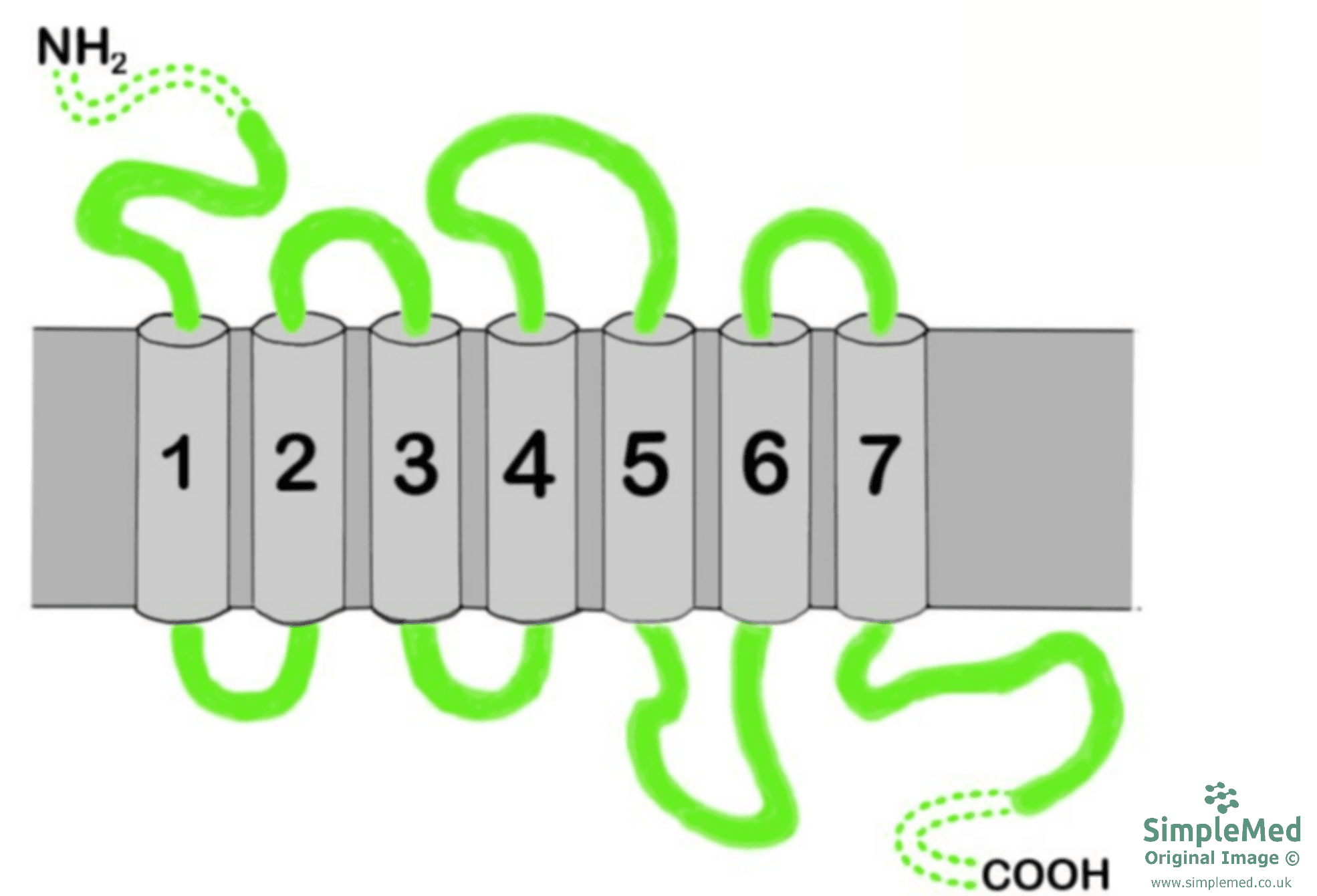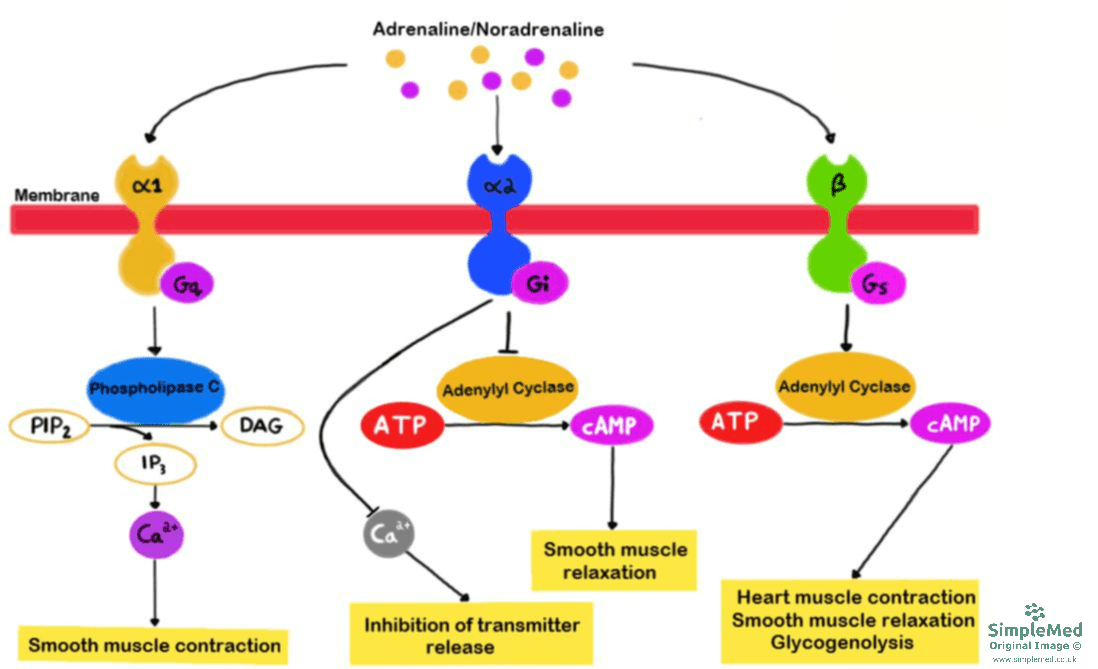By Joshua Bray
Next Lesson - Membrane Transport and Intracellular Calcium Regulation
Abstract
- Cell signalling can be summarised by the following pathway: Ligand-receptor binding => Signal transduction => Effector protein(s) => Cellular response.
- GPCRs are cell surface receptors with 7 transmembrane domains; they are coupled to G-proteins, which are peripheral proteins.
- G-proteins have an alpha subunit and a beta-gamma subunit; the alpha subunit can be classified as Gs, Gi or Gq.
- G-proteins modulate enzymes involved in second messenger production, which in turn control intracellular signalling pathways.
- Just a few ligand-receptor binding events can result in a large cellular response due to the phenomenon of signal amplification.
- The autonomic nervous system uses GPCRs to exert its effects on target tissues.
Core
A receptor is a protein molecule which binds a chemical signalling molecule – termed a ligand – and undergoes a conformational change which activates a signalling pathway to ultimately bring about a cellular response. Activation of a receptor is often followed by a second messenger production, wh.ich may activate intracellular signalling cascades – this process is known as signal transduction.
There are several classes of receptor:
- G-protein coupled receptors
- Tyrosine kinase receptors
- Ligand-gated ion channels
- Intracellular receptors
This article will focus on G-protein coupled receptors and their respective signalling pathways.
Structure of GPCRs and G-Proteins
G-protein coupled receptors, also known a 7-TM receptors, are cell surface receptors (i.e. they are present on the plasma membrane). A GPCR consists of a single polypeptide chain with an extracellular N-terminus, an intracellular C-terminus and 7 transmembrane domains. The ligand-binding site can be formed either by the N-terminus or the 2nd and 3rd transmembrane domains.

Image - Structure of a G-protein coupled receptor within a membrane, showing the 7 transmembrane domains
SimpleMed original by Thomas Burnell
G-proteins, also known as guanine nucleotide-binding proteins, are peripheral membrane proteins. They consist of 3 subunits: an alpha subunit and a beta-gamma subunit (the beta and gamma subunits are permanently fused together).
When a ligand (an agonist in this case) binds to its GPCR, the GPCR undergoes a conformational change and is said to become activated. This can be summarised by the equation R => R*. The activated GPCR then interacts with its associated G-protein by causing GTP to exchange for GDP on the G-protein’s alpha subunit. This GTP-GDP exchange results in separation of the alpha and beta-gamma subunits. These subunits can then go on to activate various effector proteins – these include second messenger enzymes and ion channels.

Diagram - Activation and deactivation of a GPCR
SimpleMed original by Josh Bray
Different types of G-protein activate different signalling pathways. In general, the G-alpha subunit will have an stimulatory or inhibitory effect on an enzyme which generates a second messenger molecule which will then go on to activate various signalling cascades. The beta-gamma subunit may also be involved in signalling, but in this article we will focus on the alpha subunit.
There are 3 main subtypes of the G-alpha protein:
Gs: The G-alphas protein activates the enzyme adenylyl cyclase, which generates the second messenger, cyclic AMP (cAMP), from ATP. cAMP activates protein kinase A (PKA) by binding and relieving it of its regulatory subunits. PKA is a kinase enzyme which phosphorylates various proteins, resulting in activation or inhibition of the target protein. This reaction may be part of a larger signalling cascade.
Gi: The G-alphai protein inhibits adenylyl cyclase, resulting in reduced cAMP generation and therefore reduced PKA activity.
Gq: The G-alphaq protein activates the enzyme phospholipase C, which converts PIP2 (a phospholipid) to IP3 and DAG (second messengers). A rise in IP3 is generally followed by an increase in intracellular calcium as it stimulates calcium release from the smooth endoplasmic reticulum (see article on membrane transport and calcium signalling).

Diagram - G-protein coupled receptor common downstream activation pathways. In this diagram, lines ending in arrows (such as acting on adenylyl cyclase in Gs) indicate an increase in action, and lines ending in a 'T' shape (such as acting on adenyly cyclase in Gi) indicate a decrease in action.
SimpleMed original by Thomas Burnell
In order to terminate signalling, the G-alpha subunit has an intrinsic GTPase domain, which slowly hydrolyses the bound GTP to GDP. Once the hydrolysis is complete, the alpha and beta-gamma subunits re-assemble and become inactive once again, resulting in termination of signalling.
The phenomenon of signal amplification means that only a few molecules of ligand are needed to elicit a relatively large cellular response.
Signal amplification is achieved via signalling cascades, where one enzyme will activate another enzyme, which will in turn activate another enzyme, and so on. The signal is amplified at each level of the cascade as a single enzyme molecule is capable of activating multiple other protein molecules.
GPCRs are important in the tissue response to the autonomic nervous system. Tissues can express adrenoceptors - which respond to sympathetically released (nor)adrenaline - and/or muscarinic receptors, which respond to parasympathetically released acetylcholine (ACh). The coupling of these receptors to their respective G-proteins can be remembered using ‘QISS QIQ’.
Adrenoceptors:
- Alpha-1 => Gq
- Alpha-2 => Gi
- Beta-1 => Gs
- Beta-2 => Gs
Muscarinic receptors:
- M1 => Gq
- M2 => Gi
- M3 => Gq

Table - A summary of the GPCRs
SimpleMed original by Joshua Bray
Alpha-1 adrenoceptors are expressed in peripheral arteriolar smooth muscle – stimulation of these receptors results in smooth muscle contraction and consequent vasoconstriction.
Beta-1 adrenoceptors can be found in the heart – stimulation of these receptors will cause an increase in heart rate and contractility.
Beta-2 adrenoceptors can be found in bronchiolar smooth muscle and also vascular smooth muscle in arterioles supplying the skeletal muscles and myocardium (i.e. coronary arteries) – stimulation of these receptors results in smooth muscle relaxation and therefore bronchodilation and vasodilation respectively.
Remember: ‘One Heart, Two Lungs’ (Beta-1, Beta-2).
The heart also expresses M2 receptors – stimulation of these receptors will cause the heart rate to decrease.
Reviewed by: Dr. Thomas Burnell and Dr. Marcus Judge
- 24567

